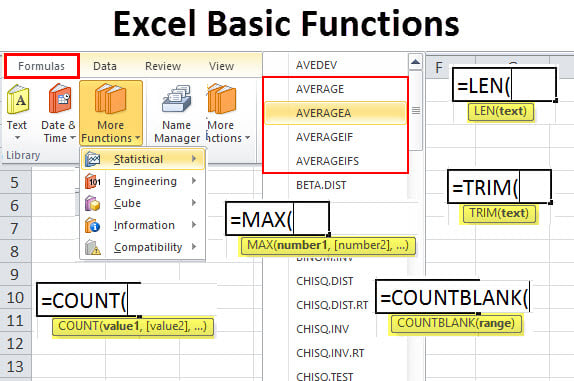

Lookup and Reference FunctionsĮxcel’s lookup and reference functions let you get data based on specific criteria and search for particular numbers within a range. The VAR function calculates the variance of a sample.Įxample: `=VAR(J2:J10)` – This formula will calculate the variance of the values in cells J2 to J10. The STDEV function calculates the standard deviation of a sample.Įxample: `=STDEV(I2:I10)` – This formula will calculate the standard deviation of the values in cells I2 to I10. The MODE function returns the most frequently occurring value in a range.Įxample: `=MODE(H2:H10)` – This formula will return the mode value in cells H2 to H10. The MEDIAN function returns the middle value of a range of numbers.Įxample: `=MEDIAN(G2:G10)` – This formula will return the median value in cells G2 to G10. Learn more about AVERAGEIF and AVERAGEIFS here. Syntax: `=AVERAGEIF(range, criteria, )`Įxample: `=AVERAGEIF(F2:F10, “>50”)` – This formula will calculate the average of values in the range F2 to F10 that is greater than 50. The AVERAGEIF function calculates the average of a range based on a specified condition. Some of the commonly used statistical functions include: AVERAGEIF These functions are valuable for making data-driven decisions. Statistical functions in Excel allow you to analyze data sets by providing measures of central tendency, variability, and more.
BASIC EXCEL FUNCTIONS FOR DATA ANALYSIS HOW TO
Learn more on how to use the basic mathematical functions in Excel here.

The COUNT function counts the number of cells that contain numbers within a given range.Įxample: =COUNT(E2:E10) – This formula will count the number of cells in the range E2 to E10 that contain numbers. The MAX function returns the maximum value from a range of numbers.Įxample: =MAX(D2:D10) – This formula will return the largest value in cells D2 to D10. The MIN function returns the minimum value from a range of numbers.Įxample: `=MIN(C2:C10)` – This formula will return the smallest value in cells C2 to C10. Syntax: `=AVERAGE(number1,, …)`Įxample: `=AVERAGE(B2:B10)` – This formula will calculate the average values in cells B2 to B10. The AVERAGE function calculates the arithmetic mean of a range of numbers. The SUM function adds a range of numbers together.Įxample: `=SUM(A2:A10)` – This formula will sum the values in cells A2 to A10. Some of the commonly used mathematical functions for data analysis include: SUM These functions serve as the foundation for more intricate calculations. The mathematical functions in Excel, which let you carry out basic arithmetic operations on numerical data, are the most fundamental tools for data analysis. Let’s now look at each category and the formulas you can use as a data analyst. Some of these functions can be used to perform data cleaning, web query, data visualization, and Analysis.Įach category serves a specific purpose and is essential for effective data analysis. In accordance with their functionality, Excel functions can be divided into a variety of types, including:Īlso available are data analysis tool-pack, pivot table and chart, solver, and user-defined formulas. Microsoft Excel is a spreadsheet program that offers users a variety of tools to carry out different tasks. Other Important Excel Functions for Data Analysis.Participants will receive a number Continuing Education Units (CEUs) upon completion, in accordance with the number of contact hours determined by Virginia Tech. MORS has partnered with Virginia Tech to offer this certificate. Finally, during the last 2 days (Week 2) an actual Capstone Project is presented: the first day of Week 2, each student works the capstone project independently, while the second day, students are grouped into teams to present the results of the Capstone to the instructors. Between weeks, a practice Capstone Project is presented to provide more opportunities to reinforce the material. On the final day, participants will create and present a Capstone Project that combines everything they have learned throughout the week.ĭuring the first 3 days (Week 1), the course material is taught with in-course work and overnight homework to reinforce the material covered. The course begins with the basics to provide a strong foundation, then builds up to a more in-depth look at various tools and functions within Excel.

Participants will learn how to conduct analysis and prepare briefs for decision makers using only Microsoft Office products. The MORS Certificate in Excel Functions for Data Analysts is a five-day course designed for beginner to mid-level analysts who wish to enhance their Excel skills and see what is new.


 0 kommentar(er)
0 kommentar(er)
